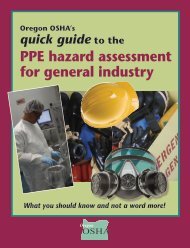Technical Manual - Section 3 (Safety Hazards)
Technical Manual - Section 3 (Safety Hazards)
Technical Manual - Section 3 (Safety Hazards)
You also want an ePaper? Increase the reach of your titles
YUMPU automatically turns print PDFs into web optimized ePapers that Google loves.
C. STABILITY CONSIDERATIONS<br />
FOUNDATION<br />
The area should be graded, leveled and maintained so that oil,<br />
water, drilling fluid, and other fluids will drain away from the<br />
working area.<br />
Safe Bearing Capacity shall be determined from the use of an<br />
appropriate table, soil core test, penetrometer test, flat-plate<br />
test, or other suitable soil test. When surface conditions are<br />
used to determine bearing capacity, care must be exercised to<br />
insure that the soil is homogeneous to a depth of at least twice<br />
the width of supplemental footing used to support the<br />
concentrated load.<br />
Supplemental footing shall be provided to distribute the<br />
concentrated loads from the mast and rig support points. The<br />
manufacturer's load distribution diagram will indicate these<br />
locations. In the absence of a manufacturer's diagram, the<br />
supplemental footing shall be designed to carry the maximum<br />
anticipated hook load, the gross weight of the mast, the mast<br />
mount, the traveling equipment, and the vertical component<br />
of guywire tension under operational loading conditions.<br />
These footings must also support the mast and mast weight<br />
during mast erection.<br />
GUYWIRES<br />
All guywires, as indicated by the manufacturer's diagram,<br />
should be in position and properly tensioned prior to<br />
commencing any work.<br />
In the absence of manufacturer recommendations, or where<br />
mast manufacturer's recommendations cannot be<br />
implemented, the diagram in Figure III:1-2 may be used.<br />
Other guying patterns may be used; however, they must be<br />
based on sound engineering principles as determined by a<br />
qualified person. These recommendations should be posted<br />
on the mast in a weatherproof container and should state the<br />
loading conditions for which they were prepared. Guywires<br />
should be 6x19 or 6x37 class, regular lay, made of improved<br />
plow steel (IPS) or better with independent wire-rope core<br />
(IWRC) and not previously used for any other application.<br />
Double saddle clips should be used, and wire rope should be<br />
installed in accordance with the manufacturer's<br />
Wellhead cellars present special foundation considerations.<br />
In addition to the obvious of collecting water and fluids that<br />
can seep into the ground, cellars also require unique mast<br />
support considerations. These should be analyzed by a<br />
qualified person to insure that an adequate mast foundation is<br />
provided.<br />
Small settlements (soil subsidence) at the beginning of rig-up<br />
is considered normal. External guywires should never be<br />
used for plumbing the mast. Rig foundations, guywire<br />
anchors and guywire tension should be checked at each tower<br />
(shift) change.<br />
Figure III:1-2. Anchor Location Diagram<br />
III:1-3
















